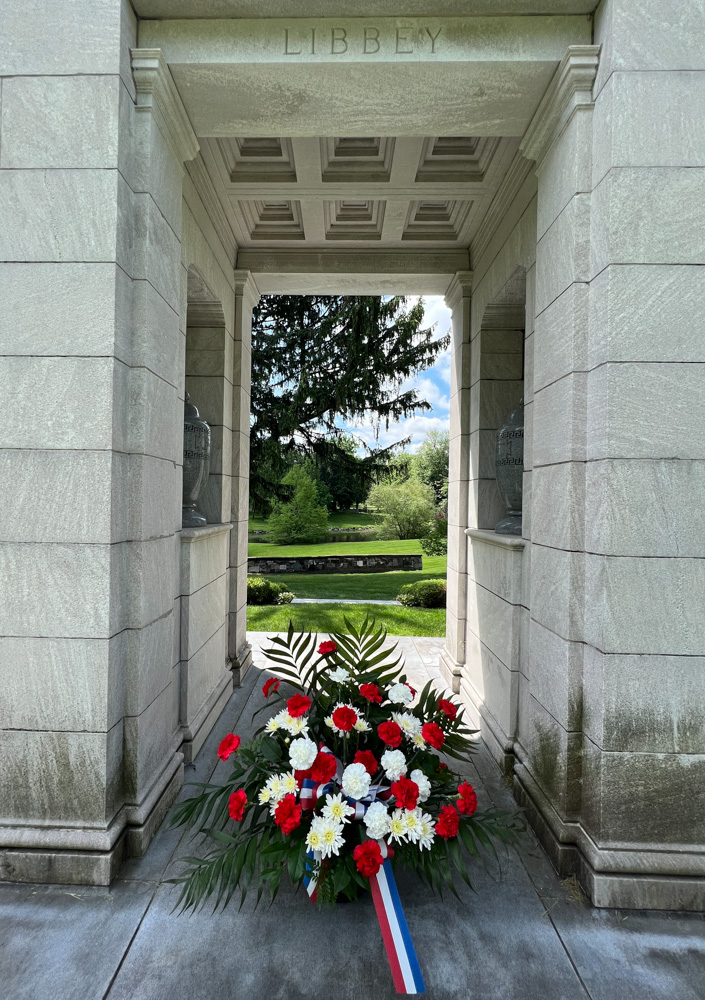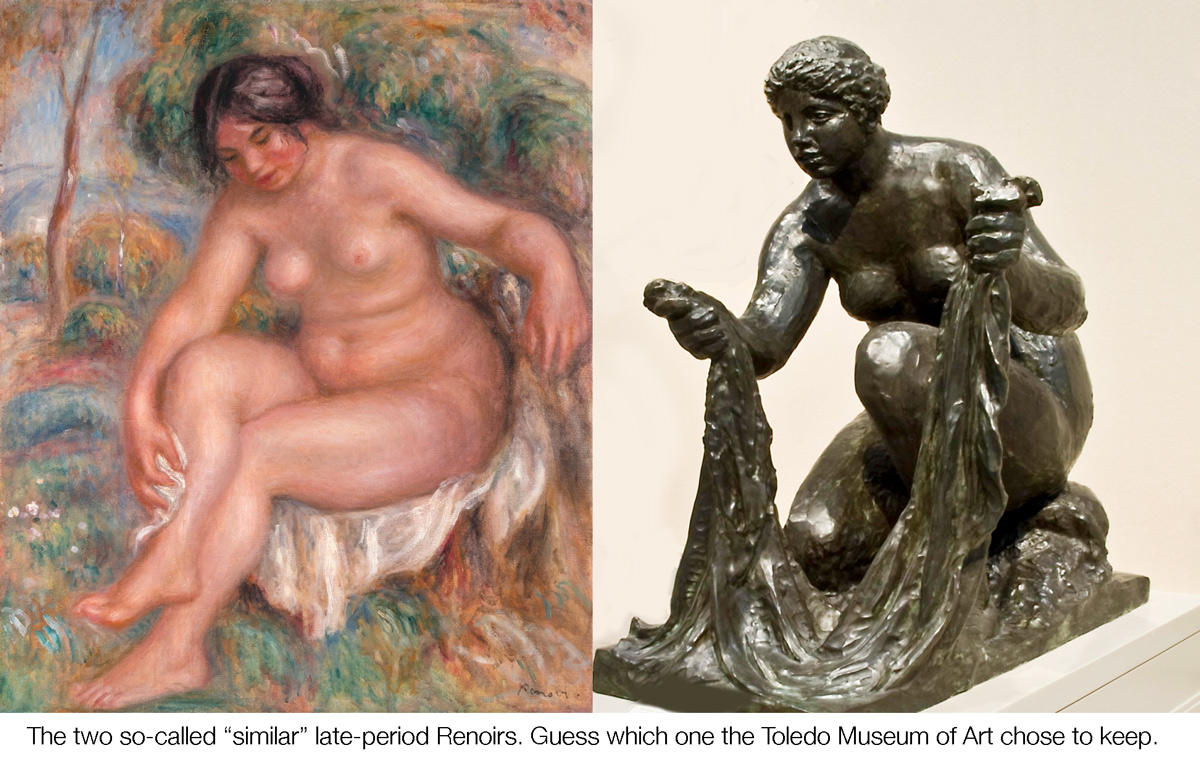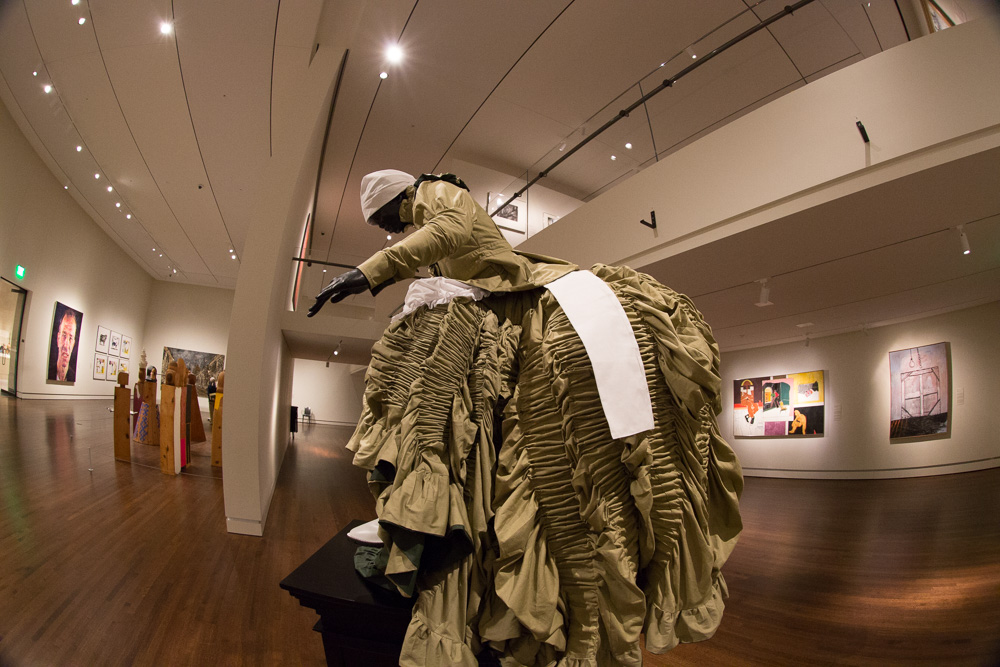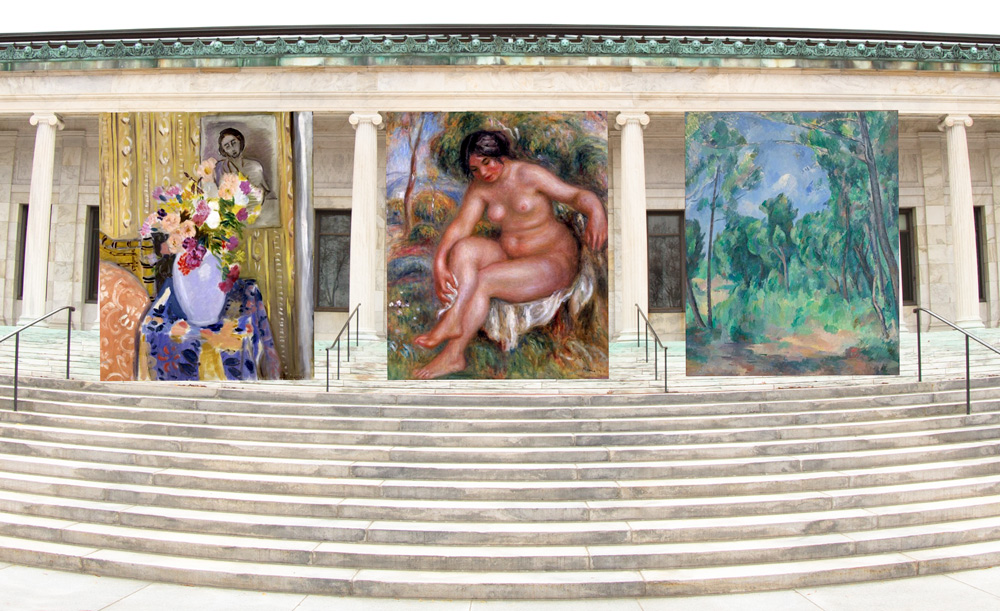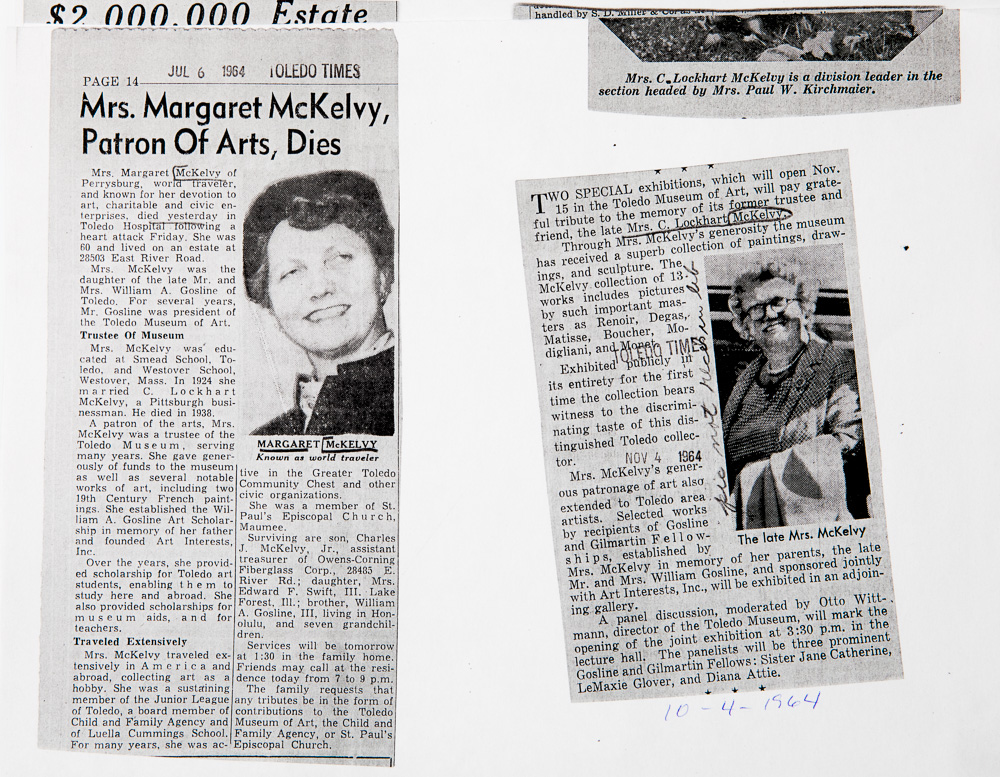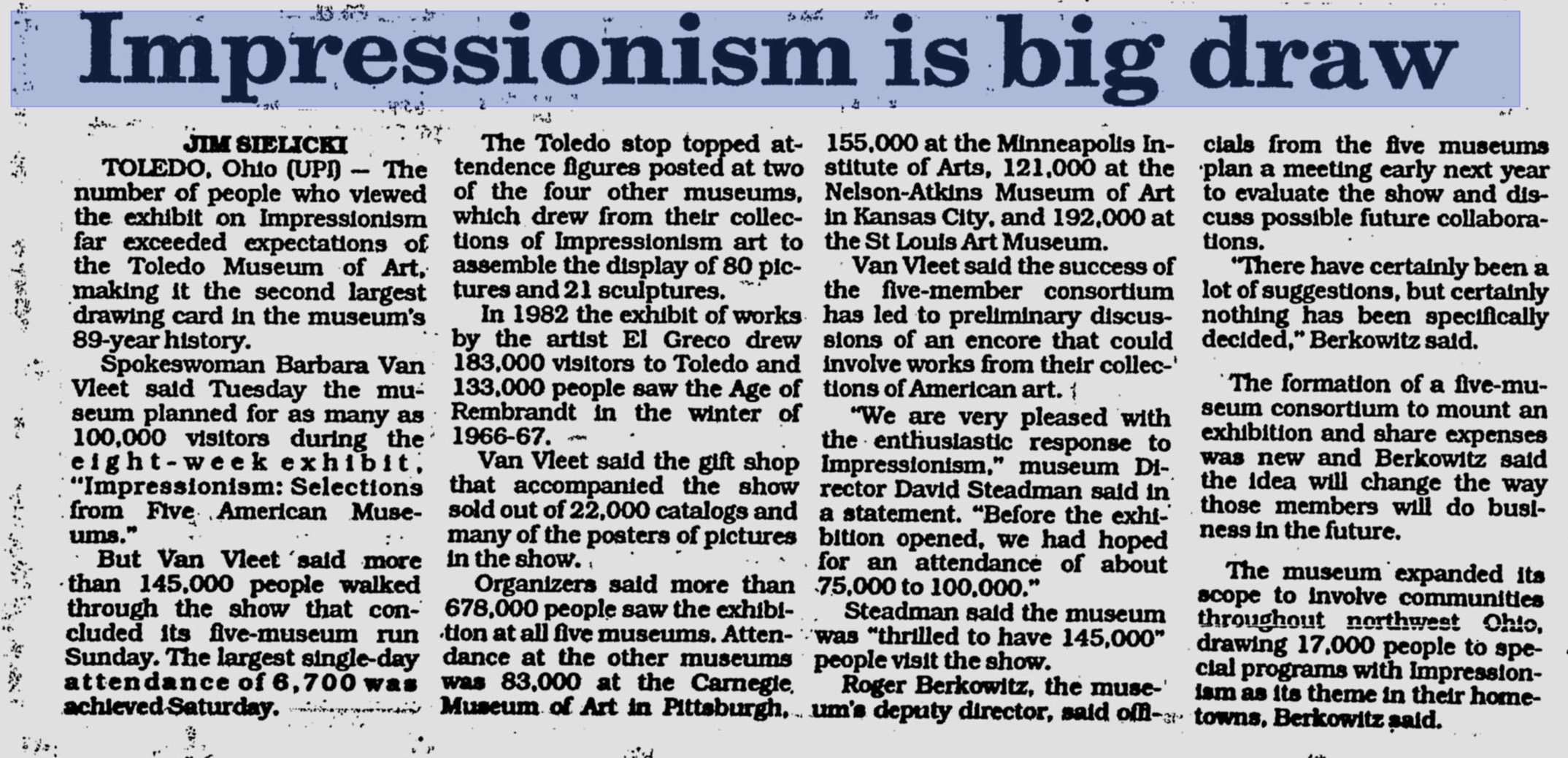What reputable museum sells valuable paintings from their great French Impressionist collection to “broaden the narrative of art history?”
Selling off Paul Cezanne’s Clairière (The Glade); Henri Matisse’s Fleurs ou Fleurs devant un portrait; and Pierre-Auguste Renoir’s Nu s’essuyant simply makes no sense. These and other proven lasting works draw people to the museum from near and far. EDITORIAL – TOLEDO MUSEUM OF ART SHOULD KEEP ITS TOP TIER The Blade, Editorial Board, April 25, 2022
Diversity is achieved through addition, not through subtraction. Removal of the works from the collection does nothing for diversity. There are ethical guidelines in the field that concern reasons for deaccession and increasing diversity is not among them. One could say that it’s performative rather than substantive. It looks like you’re doing something, when the question remains are you really doing something by taking great works of art out of a collection. – Christopher Knight, Pulitzer prize winning art critic and author of COMMENTARY: AN OHIO MUSEUM IS HOLDING THE BIGGEST SALE OF ARTWORK YET. IT’S UNCONSCIONABLE (Los Angeles Times, May 6, 2022), as quoted in the The Blade, Jason Webber, May 16, 2022, CONTROVERSY SURROUNDS TOLEDO MUSEUM OF ART SALE OF THREE PAINTINGS
The Edward Drummond and Florence Scott Libbey President, Director and CEO of the Toledo Museum of Art, Adam Levine, portrayed the Matisse, Cézanne, and Renoir paintings as being mediocre, disingenuously invoking Edward Drummond Libbey’s approval in a Libbey quote, as if Libbey would approve of the deaccessions of these valuable, famous and popular paintings. Mr. Levine wrote this in his April 8 deaccession justification letter to members:
As Edward Drummond Libbey put it in 1912: “Let the multitudinous array of the mediocre be relegated to the past and in its place be found the highest quality, the best examples and the recognition of only those thoughts which will stand for all time.”
Mr. Levine said that deaccessions, such as that of these three masterpiece paintings, are written “by design” in the wills of Edward Drummond and Florence Scott Libbey.
Twisting the intent of Edward and Florence’s wills, who by the way have paid for about 85% (just my BFA college-educated guess from looking at the museum’s online catalog) of all the art in the Toledo Museum of Art, as well as having paid for the building itself, their wills which stated that the proceeds of anything sold from the collection has to be spent on artwork only, is a basic ethical principle regarding the deaccessioning of artwork in any museum collection. But Adam Levine, 11th Director of the Toledo Museum of Art, made it seem as if Libbey intended for the art in the collection to be traded as if it was a stock portfolio! Indeed, Adam Levine told Christopher Knight in regard to selling the Cézanne, it was time to pull the trigger.
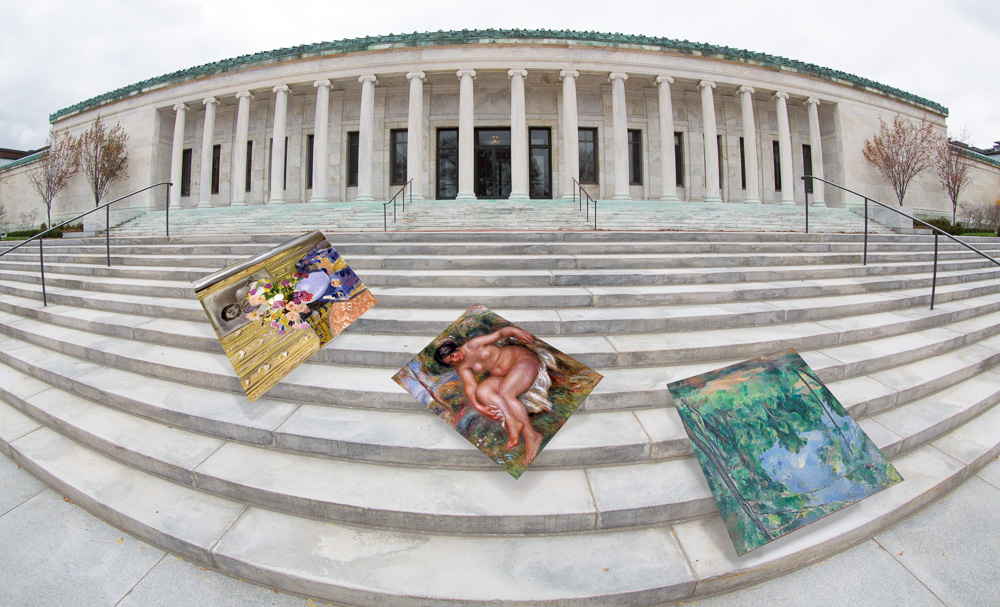
The rules in the wills
From the Edward Drummond Libbey Will:
All paintings, other pictures and works of art by me bequeathed said The Toledo Museum of Art, its successor and successors, by this my Will, or by any codicil thereto, and all paintings, pictures and other works of art by it or them acquired by expenditures from said income, shall at all times be properly and appropriately housed in one or more rooms of The Toledo Museum of Art in said City of Toledo, each of which rooms shall at all times be designated and plainly marked “The Edward Drummond Libbey Gallery”; each and every of said painting, other pictures and works of art shall at all times be plainly marked “Gift of Edward Drummond Libbey”, and shall be kept adequately insured against loss from fire, theft and other causes. Said The Toledo Museum of Art, its successor and successors, may temporarily loan for the purposes of public exhibition elsewhere any such painting or other picture or work of art, upon taking proper security for its safe return; and it and they may, from time to time and at its and their discretion, sell or exchange any painting or other picture or work of art purchased by expenditures from said income, and from the proceeds thereof may acquire some other or others.
From the Florence Scott Libbey Will:
One-half (1/2) thereof in the purchase of paintings, statuary, furniture and other works of art, each of which, when so acquired, shall have designated thereon, or near thereto, the following words: “Florence Scott Libbey Bequest in Memory of her Father, Maurice A. Scott”, and shall be permanently installed in one or more rooms of the building or buildings of said Museum of Art, each of which shall be designated and known as the “Maurice A. Scott Memorial Gallery” and the other one-half (1/2), thereof to be used and expended by said The Toledo Museum of Art, its successor and successors, for any of its corporate purposes. Any articles, so purchased, if deemed advisable or desirable, may be sold or exchanged, and the proceeds of every such sale used as income in the purchase of some other work of art.
Building the museum’s fine collection took many years, and much effort went into it. French Impressionism is popular and valuable work; it is very accessible; it is considered to be the starting point of modern art. The Matisse (purchased in 1935) and Cezanne (purchased in 1942) were purchased with funds from the Libbey Endowment, Gift of Edward Drummond Libbey.
Adam Levine wrote in his April 8 letter to museum supporters:
The Toledo Museum of Art has never sought to have multiple examples by the same artist—fewer than 11% of the artists in our collection are represented by two or more paintings;
We will use these proceeds to create a new acquisition endowment.
YIKES!
using the sales of the Cézanne, Matisse, and Renoir to create a new acquisition endowment!! But doesn’t the Libbey will specify that proceeds from any sale be used for art, right now, not to be used to create a new entity of a new endowment — the money is not even going back to the Libbey Endowment to be used on art soon enough? What about the Libbey name and attribution to the gift of the artwork that will be purchased? What about Mrs. McKelvy? What the heck! What’s the set-up cost going to be for this “new endowment” and how many hands are in that pot?
Gee Wiz!
If only Adam Levine had been fired on the spot after he came out with his crude George Floyd memo that stated how the staff should stay neutral. Instead, the museum trustees went along with his rationalization that there was something fundamentally wrong with our museum, as if it reflects bias and discrimination against the black community. Nothing could be further from the truth, except for the hiring of Adam Levine and keeping him on after he published his thoughtless memo.
A field day
The Toledo Black Artist Coalition had a field day.


This year, the museum opened its doors on a Monday for the first time in 110 years to celebrate Martin Luther King Jr. Day. It just happened to be the 110th anniversary of the day the museum opened the doors for the very first time, ever. But there was no mention of that at the museum. Mum was the word. I was there, and I asked several employees, including a trustee who was going around introducing herself, and none of them knew. The museum historian knew though — they called and asked her! Couldn’t the museum figure out how Martin Luther King Jr. Day and the 110th anniversary of the opening of the new museum could be celebrated together? How pathetic that they had to sell out the museum’s history in order to honor black history.



The “brand” of “belonging”
Is it good stewardship for the Director of The Toledo Museum of Art, Adam Levine, to add two new departments — “Branding” and “Belonging” – erasing and re-writing the museum for the black community (some would call it pandering), while at the same time dismantling the museum’s wonderful French Impressionism collection for $50+ million? Adam Levine has ridded us of a good third or more of our valuable, popular, historically significant French Impressionist paintings, calling it in the name of “diversity.” One thing is for sure, he is getting a lot of negative publicity.
And then there’s this.
To sell our Renoir, Matisse and Cézanne out from under our valuable public collection, into secret, private hands, only for us to find out that the two most expensive paintings were sold to the same buyer, sales that are shrouded by the convenient secrecy of a Sotheby’s auction, then to discover a casino connection to our former “interim” director, John Stanley… who strangely became the museum spokesman for The Blade’s article on May 16, 2022, CONTROVERSY SURROUNDS TOLEDO MUSEUM OF ART SALE OF THREE PAINTINGS saying that, basically, what do those people who object to the deaccessions know about art anyway, and “this is the world we live in….” It’s outrageous!
Hired to oversee the business aspects of the 2018 plans for the museum building renovation, then used as the interim director when Brian Kennedy suddenly left the museum one year before the end of his contract, John Stanley isn’t on the board of museum trustees, but for some reason, he is on the so-called “Art Committee” that recommended the deaccession (even though he has no degree in art – only in business and finance, and was hired by the museum to work on the new construction – so what does he know about art?) But when the going got tough with the public outcry against the auction, John Stanley was the spokesman the art museum put out front to deal with it.
And speaking for the museum on Facebook was the charming troll-like, aptly-named “Brandi Black.” She appeared on top of every Blade article about the deaccession, and also on my Toledo Now page, posting sarcastic ad hominem and name-calling attacks on everyone who dared to question the sales of the paintings. She used the face of Supreme Court Justice, Ketanji Brown Jackson. Not everyone would recognize the honorable judge’s friendly face. Judges are meant to be behind the scenes, after all. They are not celebrities. “Brandi Black” changed her Facebook moniker picture to Ketanji Brown Jackson (from a white cartoon face) on the day before Adam Levine announced the deaccession. Hmmm…. Did the museum actually hire her, or was she just volunteering? Only the Brand Director knows for sure. Either way, she certainly made the museum look bad!

What are the odds?
Check out this article about the rental of 21 Monet paintings to a Las Vegas casino by the Institute of Fine Arts, Boston, during the time that John Stanley was the COO of that museum.

How interesting to find out that John Stanley was the COO at the Institute of Fine Arts, Boston when they rented out 21 French Impressionist Monet paintings from the museum’s stellar collection to a Las Vegas casino, the Bellagio, for a generous rental fee.
The owner of the Bellagio casino, Steve Wynn, is an avid collector of French Impressionist art; such articles are easy to find on Google.
Is it possible that the sale of our valuable French Impressionist paintings could have been prearranged?

It’s our museum!
The trustees are expected to be good stewards of our museum. The least they can do is to take care of our art and heritage and not sell it off. Our museum is not to be used as a catalog of artwork for sale. After this deaccession tragedy, shouldn’t we be seriously safeguarding our multiple Rembrandt and van Gogh oil paintings and other valuable paintings from being casualties of a future corrupt deaccessioning, now that we know that such a travesty is not only possible, but suspiciously probable, considering the circumstances surrounding the loss of our three valuable French Impressionist paintings this month?

P.S.
Why does the museum put flowers on the grave of the Libbeys, three times a year — on Easter Day, Memorial Day, and on November 13?
Because they have to – it’s in Florence Scott Libbey’s will. But I wonder, since Adam Levine and the museum trustees are making such swift and radical changes out from under the original intentions of the founders of our great, progressive museum — calling our museum out for being somehow socially unjust, when our museum has been the most democratic and forward-thinking museum of them all, selling artwork gifted by the Libbeys to make a new acquisition endowment, just how long will the trustees be keeping those flowers going on that grave?
P.P.S.
And what have they done to the Ward M. Canaday Gallery? There are no exhibitions in it anymore — they’ve had a movie playing in it for the past eight months. Are they going to sell the name of the gallery (their 2018 renovation construction plan illustrations replace the space with a generic name, capitalized, “Center Gallery”) to a philanthropist for a period of time until death puts the patron cold in the grave, at which time the museum will rinse and repeat? Will the Frederic and Mary Wolfe Gallery be at risk, as well? Is this part of Mr. Levine’s big money-making, blood-sucking, self aggrandizing plan to make our museum the envy of every museum in America?
The Toledo Museum of Art used to be the envy of every museum in America before the trustees diminished its great children’s art classes that served the entire Toledo area school system. Over 2,000 children of all ethnicities, chosen by the schools’ principals with recommendations from teachers, choosing children for the program on the merit of the child’s apparent proclivity for artistic creativity, attended art classes every Saturday during the school year, for nearly the entire 20th century. The Libbeys’ wills actually mention more in regard to the importance of education than they speak of art.
Not to mention that the museum killed the 96-year old tradition of the annual Toledo Area Artists Exhibition and got rid of the exhibition’s purchase award collection at the Toledo Museum of Art, banishing it to a closet in a Toledo high school. Included in the collection are works by such diverse local artists as Marvin Vines and Robert Garcia. Maybe the Director of Belonging and Community Engagement ought to look into this closet collection and bring the Toledo Area Artists Exhibition back. The Canaday Gallery seems to be readily available.
All the museum has to do to make itself enviable again is look back on its own history of how it engaged the community – check down in that memory hole and pull it back up.
The bodies are still warm.
A timeline journal of articles and events surrounding the deaccession:
Toledo Museum of Art’s Controversial Unconscionable Tragic High-Profile Deaccessions

